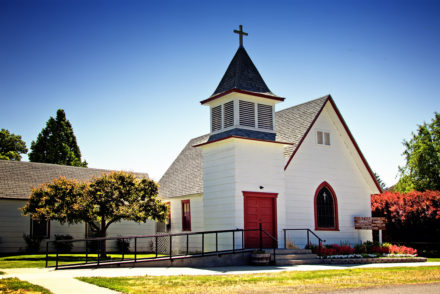Note: This is the final blog in a year-long series of posts on the parables of Jesus. You can find the first blog on the parables HERE.
Jesus spoke about the judgment of God as much as he spoke about any other subject. Jesus spoke about the judgment of God on those who reject the son (John 3:36). He spoke about the judgment of God in the here and now for rejecting the truth of God’s kingdom (John 9:39-41). And he spoke about the judgment in the last days (Matthew 12:37-37). There is a sense in which the Jews of Jesus’ day relished the message of judgment. They longed for the day when God would judge his enemies, especially the Romans, and restore Israel to its former economic and political glory. But Jesus always made his messages of judgment very personal. He often warned his hearers that there would be many in the last days waiting for the judgment to fall upon someone else only to find the judgment of God falling upon them instead. There are a number of parables of judgment in the New Testament to illustrate this trend in Jesus’ teaching. The most illustrative of these, for our purposes, is the parable of the “ten virgins” in Matthew 25:1-13.
Question 1: What are the immediate circumstances of the parable?
The final major discourse in Matthew’s Gospel is the Olivet Discourse in Matthew 24 and 25. The discourse is introduced to us by Matthew by allowing us to listen in on a conversation between Jesus and his disciples. They are having a conversation about the temple grounds and buildings when Jesus points to all the buildings and says, “Truly, I say to you, there will not be left here one stone upon another that will not be thrown down.” This, obviously, gets the disciples’ attention. The disciples then ask two questions: 1) “When will what you said happen?” 2) “What will be the sign of your coming and the end of the age?” What follows is Jesus’ most lengthy discourse on the “end times,” and in Chapter 25, Matthew tells us three of Jesus’ “end times” parables. The parable about the “ten virgins” is the first of these.
Question 2: What is the structure of the parable?
The parable of the ten virgins has a story structure with rising action, a climax, and a resolution. It tells the story of a Mediterranean-style wedding party. If you were to read three Bible dictionaries and background commentaries on this passage, you’d probably get three very different explanations of exactly how these wedding parties happened in ancient Israel, but those kinds of details matter very little to this story. Ten unmarried women light their lamps and go out to meet the bridegroom when he returns from the wedding celebration. They are going in the evening and need to be prepared for the darkness, so they all take lamps with them. Five of the young women do not take any oil for their lamps because they are foolish. Five of the young women do take oil for their lamps. The bridegroom is delayed so they all go to sleep. This is the rising action. Then, at midnight, the bridegroom returns! It is time for the young women to go out to meet him and to join the party. The five wise, prepared virgins have oil to light their lamps, and off they go. The five foolish virgins do not. They are unprepared for the bridegroom. They rush out to try to buy more oil, and the wise virgins go into the marriage feast. The door to the feast is shut, and when the foolish virgins return, the lord of the feast says to them, “I do not know you.” This is the climax of the parable. The resolution is in Jesus’ final words: “Watch therefore, for you know neither the day nor the hour.”
Question 3: Is there anything in the details of the parable modern readers need to understand?
Scholars have pressed hard to try to identify the various components of a Middle Eastern marriage ceremony and find them in the details of this parable, but the parable of the ten virgins requires little of that. In fact, the parable if filled with familiar language from the teaching of Jesus to make his meaning abundantly clear. The identification of the one they are waiting for as the “bridegroom” harkens back to a long list of Old Testament references identifying God as a bridegroom to his people (e.g. Jeremiah 2). The coming of the bridegroom in the middle of the night when people aren’t expecting it is a regular theme in both the Old and the New Testaments (e.g. Matthew 24:43, Exodus 11-12, etc.). Nearly all the material about the “end times” in the New Testament talks about being prepared (e.g. 1 Thessalonians 5:4-8, Revelation 15:16, etc.). The cry of the foolish virgins of “Lord! Lord!” is familiar language from the teaching of Jesus regarding people who call on him but who don’t really believe in him (e.g. Matthew 7:21-23, Luke 6:46, etc.). And the final judgment of the Lord—“I do not know you”—is also familiar in the teaching of Jesus and familiar language from the Old Testament. There are those who are among God’s visible people that the Lord does not know (e.g. Matthew 7:21-23) and there are those whom God knows as his people (e.g. Genesis 18:18-19, Amos 3:2, etc.).
Question 4: What is the meaning of the parable?
Putting together the pieces of the parable of the ten virgins isn’t particularly difficult. It is, first of all, a declaration to God’s people. There will always be those who are among God’s people, who look like God’s people, but they are not truly God’s people. There is coming a day when no one will be able to hide. Their “foolishness” will be made manifest, and their true relationship to God will be revealed. He does not know them. It is also a warning to all who will listen. Proximity to God’s people does not make anyone known by God. Being a virgin, having a lamp, going to the party are not sufficient. In the same way having Christian parents, growing up in church, knowing the Bible are not sufficient. Only those known by the bridegroom get into the wedding feast. But notice there is not some secret knowledge at work here. Five virgins aren’t secretly selected for condemnation only to be surprised by their fate in the end. It is obvious to all who read this parable who will get into the wedding feast. The foolish virgins are only surprised at their fate because they are foolish. They knew to take oil, but they didn’t. They had the example of the wise virgins, but they ignored it. When push came to shove, they hoped to get by on the faithfulness of the wise virgins, but borrowed faithfulness is no faithfulness at all. Jesus understands that the human heart, upon hearing of this judgment, will be quick to conclude, “I need be different. I need to believe. I need to repent and be known by him someday.” Jesus concludes with a warning: “You might not have as much time as you think you do.”
***********
I hope this blog series has helped you become a better reader of Jesus’ parables. I know it has helped me. As you read the parables for yourself, never forget that Jesus speaks in parables both to reveal and to obscure. Jesus often uses parables so that we might better see him and ourselves in a spiritual light. Parables are not morality tales that teach us to be nice to people or else we’ll get into trouble. They are extended metaphors to help the faithful (and often the skeptical) to understand the messiah, salvation, and the kingdom of God. The parables of Jesus have deep gospel roots. They are dramatic, powerful, and deeply spiritual conveyers of truth in terms so plain that only those who are intentionally spiritually blind cannot see.





